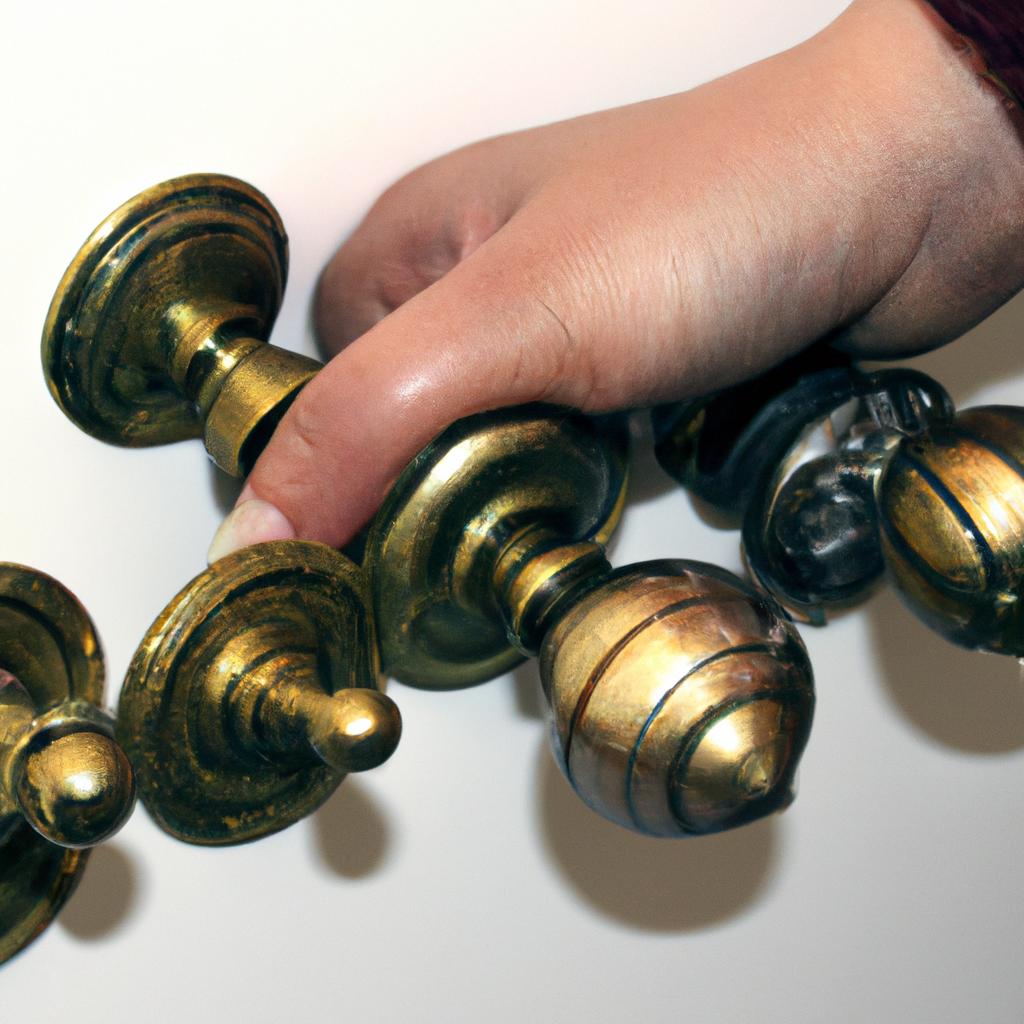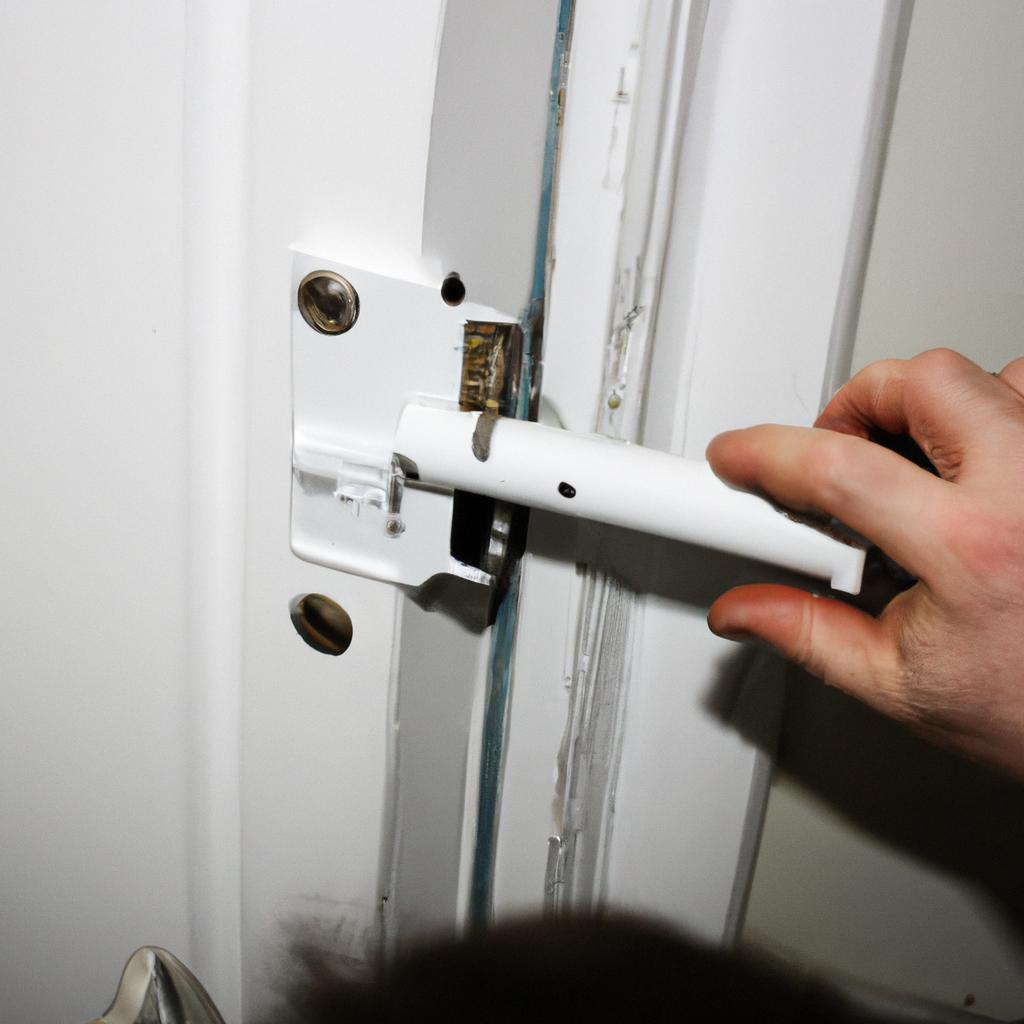Door hinges play a crucial role in the construction and functionality of doors, making them an essential component in the realm of lumber and building materials. These small but significant pieces are responsible for allowing doors to swing open and closed smoothly while providing stability and security. To better understand the importance of door hinges in this context, let us consider a hypothetical scenario: Imagine entering a newly constructed house only to find that the entrance door squeaks loudly every time it is opened or closed. This experience not only disrupts one’s peace but also raises questions about the quality of craftsmanship involved. In light of such scenarios, it becomes imperative to explore the various types, materials, and considerations associated with door hinges when venturing into the world of lumber and building materials.
In order to appreciate the significance of door hinges within the domain of lumber and building materials, it is important to acknowledge their impact on both form and function. Functionally speaking, they allow doors to move seamlessly by enabling smooth rotation around their pivots or axes. On a functional level, improper hinge installation can lead to excessive friction or misalignment, resulting in operational issues such as creaking sounds, difficulty opening or closing doors, or even complete failure of operation. From an aesthetic standpoint, well-designed door hinges can enhance the overall appearance of a door. They can be decorative elements that complement the style and design of the door, adding a touch of elegance or uniqueness to the space.
When it comes to types, there are several options available in the market. The most common types include butt hinges, continuous/piano hinges, pivot hinges, and concealed/hidden hinges. Butt hinges are the most traditional and widely used type, consisting of two metal plates attached to both the door and frame sides. Continuous/piano hinges run along the entire length of the door, providing added support and durability for heavy doors. Pivot hinges allow doors to swing in both directions around a central axis point, making them suitable for areas with limited space or unique architectural designs. Concealed/hidden hinges are designed to be invisible when the door is closed, creating a sleek and seamless look.
Material selection is another crucial consideration when choosing door hinges. Common materials include steel, brass, bronze, and stainless steel. Steel hinges are durable and cost-effective but may require regular maintenance to prevent rusting. Brass and bronze hinges offer an aesthetic appeal with their warm tones but are generally more expensive than steel ones. Stainless steel hinges provide excellent corrosion resistance and durability while offering a modern look.
In conclusion, door hinges play a vital role in ensuring smooth operation and enhancing the aesthetic appeal of doors in construction projects. Understanding different hinge types, materials, and installation considerations can help achieve optimal functionality and visual impact when choosing these essential components for your lumber- or building-related endeavors
Types of Door Hinges
Types of Door Hinges
Imagine walking into a beautifully designed home, and as you reach for the doorknob, you notice something interesting – the door swings open effortlessly on hidden hinges. This example highlights just one type of door hinge, but there are many others that serve different purposes and offer unique features. Understanding the various types of door hinges can help homeowners, architects, and builders make informed decisions when selecting hardware for their doors.
1. Butt Hinge: The most common type of door hinge is the butt hinge. As its name suggests, this hinge consists of two rectangular metal plates joined by a pin or rod at one end. It is commonly used in residential applications due to its simplicity and durability. Butt hinges are often recessed into the edge of the door and frame, providing a clean and seamless appearance.
2. Pivot Hinge: Pivot hinges allow doors to rotate on a single point instead of swinging on traditional side-mounted hinges. They are commonly found in commercial settings where heavy-duty doors require smooth operation without sagging or misalignment over time. Pivot hinges provide stability and distribute weight evenly along the floor, making them suitable for large glass doors or entrances requiring impressive architectural designs.
3. Continuous Hinge: Also known as piano hinges, continuous hinges run the entire length of the door panel’s height. These long strips of metal provide consistent support throughout the door’s length while ensuring smooth movement with reduced wear and tear over time. Continuous hinges are commonly seen on high-traffic areas like schools or hospitals where frequent use demands longevity.
4. Concealed Hinge: For those seeking minimalist aesthetics, concealed hinges may be an ideal choice. These innovative hinges are entirely hidden from view when the door is closed, creating a sleek look free from any visible hardware elements disrupting design harmony.
To further illustrate these options visually:
| Butt Hinge | Pivot Hinge | Continuous Hinge | Concealed Hinge | |
|---|---|---|---|---|
| Description | Rectangular plates joined by a pin or rod. | Allows doors to rotate on a single point. | Long strip running the entire height of the door. | Hidden from view when door is closed. |
| Common Use | Residential applications due to simplicity and durability. | Commercial settings with heavy-duty doors. | High-traffic areas requiring longevity. | Minimalist designs seeking concealed hardware. |
| Advantages | Simple design, easy installation, durable construction. | Smooth operation, even weight distribution. | Reduced wear and tear, consistent support throughout the length of the door. | Sleek appearance, no visible hinges disrupting aesthetics. |
By exploring these types of door hinges – butt hinges, pivot hinges, continuous hinges, and concealed hinges – individuals can find options that not only meet their functional requirements but also enhance the overall look and feel of their spaces.
This understanding leads us to delve further into the materials used in creating these essential components for effectively hanging doors without compromising structural integrity.
Materials Used in Door Hinges
Now that we have explored various types of door hinges, it is equally important to understand the different materials employed in their construction and how they contribute to hinge performance and durability.
Materials Used in Door Hinges
Section H2: Types of Door Hinges
[Unique transition from the previous section]Now, let’s delve into the materials used in door hinges. Understanding the different materials employed in manufacturing door hinges is crucial for selecting a hinge that suits your needs and preferences.
When it comes to door hinge materials, there are several options available on the market. Each material has its unique characteristics, which can impact factors such as durability, appearance, and cost. To illustrate this point further, let’s consider an example: imagine you are renovating an old wooden cabin nestled deep within a dense forest. You want to maintain the rustic charm of the place while ensuring long-lasting functionality for the doors. In this case, opting for bronze or brass door hinges would be ideal due to their aesthetic appeal and ability to withstand environmental elements.
To provide you with a comprehensive overview of the different materials used in door hinges, here are some key points:
- Steel: This material offers excellent strength and durability while being relatively affordable compared to other options.
- Zinc alloy: Known for its corrosion resistance and versatility, zinc alloy hinges can be found in various finishes to complement any interior design.
- Stainless steel: Highly resistant to rust and suitable for both indoor and outdoor applications, stainless steel hinges offer longevity without compromising aesthetics.
- Brass/bronze: These metallic alloys exude elegance and sophistication. They’re often chosen for traditional or vintage-style homes due to their timeless beauty.
Now let’s take a closer look at how these materials compare in terms of specific properties by referring to the following table:
| Material | Strength | Durability | Corrosion Resistance |
|---|---|---|---|
| Steel | High | High | Low |
| Zinc Alloy | Medium | Medium | Medium |
| Stainless Steel | High | High | High |
| Brass/Bronze | Medium | High | High |
By understanding the characteristics of different materials used in door hinges, you can make an informed decision based on your specific requirements and desired outcomes. Now that we have explored the various materials available let’s move on to examining some critical factors to consider when choosing door hinges.
[Transition into next section]Factors to Consider When Choosing Door Hinges
H2: Materials Used in Door Hinges
As we delve further into the world of door hinges, it is essential to understand the materials commonly used in their construction. This knowledge can help you make informed decisions when choosing the right hinge for your specific needs.
One example that showcases the importance of material selection is a case study on residential doors. Imagine a homeowner who lives in an area with high humidity levels. In this scenario, using hinges made from stainless steel or brass would be beneficial due to their corrosion-resistant properties. These materials are known for their ability to withstand moisture and prevent rust formation, ensuring longevity and functionality even in challenging environmental conditions.
When considering materials for door hinges, several factors come into play. Here are four key elements to consider:
- Durability: The material should be able to withstand regular use without wearing out or breaking easily.
- Strength: It is crucial to choose a material that can support the weight of the door and any additional stress it may encounter.
- Corrosion Resistance: Depending on the environment or climate where the hinges will be installed, selecting a material that resists corrosion can prolong its lifespan.
- Aesthetic Appeal: The appearance of the hinge should complement the overall design aesthetic of your space.
To illustrate these considerations more clearly, here’s a comparison table highlighting some common materials used in door hinges:
| Material | Durability | Strength | Corrosion Resistance | Aesthetic Appeal |
|---|---|---|---|---|
| Stainless Steel | High | High | Excellent | Modern and sleek |
| Brass | Moderate | Moderate | Good | Classic |
| Zinc Alloy | Low | Moderate | Fair | Versatile |
| Aluminum | Moderate | Low | Good | Lightweight |
By carefully evaluating these aspects alongside your specific requirements, you can select a suitable hinge material that will not only serve its functional purpose but also enhance the overall aesthetic appeal of your doors.
As we now move on to exploring the factors involved in installing door hinges, it is important to keep in mind the crucial role materials play in ensuring a successful installation and long-term performance.
Installing Door Hinges
In the previous section, we discussed the various factors that should be taken into consideration when choosing door hinges. Now, let us delve deeper into this topic and explore these factors in more detail.
Imagine a scenario where you have just purchased a beautiful solid wooden door for your home. You want to ensure that it not only enhances the aesthetic appeal of your space but also functions smoothly and securely for years to come. To achieve this, selecting the right door hinge is crucial. Let’s consider an example: John recently installed a heavy oak door at his entrance, using hinges that were unable to support its weight. As a result, the hinges began to sag over time, causing difficulty in opening and closing the door properly.
To prevent such issues, here are some key factors to keep in mind when choosing door hinges:
- Weight-bearing capacity: Ensure that the chosen hinges can handle the weight of your door without sagging or becoming misaligned.
- Material quality: Opt for high-quality materials like stainless steel or brass that offer durability and resistance against rust and corrosion.
- Style compatibility: Select hinges that complement the overall design theme of your space, whether traditional, modern, or contemporary.
- Security features: Consider additional security measures such as non-removable pins or concealed screws for added protection against forced entry.
Now let’s evoke an emotional response by presenting you with a brief checklist highlighting why investing in suitable door hinges is essential:
- Peace of Mind: Properly functioning hinges provide peace of mind knowing that your doors will open and close smoothly every time.
- Longevity: High-quality hinges ensure longevity by resisting wear and tear caused by continuous usage.
- Enhanced Aesthetics: Well-chosen hinges can enhance the visual appeal of your doors and integrate seamlessly with your interior design.
- Security Assurance: By opting for secure hinge options, you can significantly increase the safety level of your home.
To further assist you, here is a table comparing different types of door hinges based on their features:
| Hinge Type | Weight-Bearing Capacity | Material | Style Compatibility |
|---|---|---|---|
| Butt Hinges | High | Stainless Steel, Brass | Traditional |
| Pivot Hinges | Medium to High | Steel | Modern |
| Concealed Hinges | Medium to High | Zinc Alloy, Aluminum | Contemporary |
By considering these factors and making an informed choice, you can ensure that the door hinges not only fulfill their functional purpose but also contribute to the overall aesthetics of your space. In our next section, we will discuss maintenance and care tips for prolonging the lifespan of your door hinges without compromising performance or security.
Maintenance and Care for Door Hinges
Section H2: Maintenance and Care for Door Hinges
Having learned about the proper installation of door hinges, it is essential to understand how to maintain and care for them. Neglecting regular maintenance can lead to premature wear and tear, compromising the functionality of your doors. In this section, we will explore effective strategies for ensuring the longevity and optimal performance of your door hinges.
Maintenance Case Study:
Imagine a scenario where a homeowner neglects to regularly lubricate their door hinges. Over time, the lack of lubrication causes friction between the hinge components, resulting in squeaky and stiff movement whenever the door is opened or closed. This situation could have been easily avoided with routine maintenance.
Effective Maintenance Tips:
To keep your door hinges in excellent condition, consider implementing these practical maintenance practices:
- Lubrication: Regularly apply a suitable lubricant (such as silicone spray or graphite powder) to reduce friction and ensure smooth operation.
- Cleaning: Remove any accumulated dirt, dust, or debris by wiping down the hinges with a soft cloth or using a mild cleaning solution.
- Inspection: Periodically check for signs of damage or loose screws on your hinges. Tighten any loose screws promptly to prevent further issues.
- Adjustment: If you notice misalignment causing binding or sticking when opening/closing your door, adjust the hinge position accordingly.
Regular maintenance helps:
- Prolong the lifespan of your door hinges
- Prevent unnecessary repairs or replacements
- Ensure smooth and effortless operation
- Enhance security by eliminating potential weak points
Table – Common Materials for Lubricating Door Hinges:
| Lubricants | Advantages | Disadvantages |
|---|---|---|
| Silicone Spray | Provides long-lasting lubrication | May attract dust and dirt |
| Graphite Powder | Offers excellent dry lubrication | Can be messy during application |
| White Lithium | Resistant to extreme temperatures | May require more frequent reapplication |
| Grease | Provides heavy-duty lubrication | Not suitable for all hinge types |
By understanding how to properly care for your door hinges, you can minimize potential issues and ensure their smooth operation. However, even with regular maintenance, certain problems may arise. In the following section, we will explore common issues related to door hinges and provide practical solutions to address them effectively.
Common Issues with Door Hinges and How to Fix Them
With a solid understanding of how to maintain and care for door hinges, it is essential to be aware of common issues that may arise and the appropriate steps to address them. This section will explore some of the most prevalent problems encountered with door hinges and provide solutions on how to fix them effectively.
Example Scenario: Imagine a homeowner who recently noticed their bedroom door making squeaking noises every time it was opened or closed. This squeaky hinge can be quite bothersome, especially during late-night movements in the house. It is crucial to identify the cause and find an appropriate solution promptly.
- Loose Screws:
- Inspect all screws on the hinge plates, both on the door frame and the door itself.
- Tighten any loose screws using a screwdriver, ensuring they are secure but not overtightened.
- If screws are stripped or cannot hold securely due to wear, consider replacing them with slightly longer ones for better grip.
- Rust Build-up:
- Examine each hinge carefully for signs of rust or corrosion.
- Gently clean away any visible rust using a wire brush or fine-grit sandpaper.
- Apply a thin layer of lubricant or anti-rust spray to prevent further rusting and ensure smooth movement.
- Misalignment:
- Check if there is any noticeable misalignment between the door and its frame when closed.
- Loosen the screws holding the affected hinge plate(s) slightly.
- Adjust the position of the misaligned hinge by tapping it gently with a hammer until properly aligned.
- Retighten the screws firmly once alignment is achieved.
- Worn-out Hinge Pins:
| Signs of worn-out hinge pins | Solution |
|—————————–|———|
| Difficulty opening/closing doors smoothly | Replace worn-out hinge pins with new ones |
| Visible gaps between hinge knuckles | Remove old pins using a pin punch and hammer, then insert new ones |
| Excessive door movement or sagging | Ensure the replacement pins are of appropriate size and material |
By addressing these common issues promptly, homeowners can ensure their doors operate smoothly and maintain their functionality for years to come. Remember that regular maintenance, such as lubrication and periodic inspections, can also help prevent future problems with door hinges.
Note: It is important to consult professional assistance if any issues persist or require advanced repair techniques not covered in this guide.
 Bergmann Lumber
Bergmann Lumber



